Louth, Lincolnshire
Up to 1834
Eden, in 1797, reported on poor-relief in Louth:
A building on Northgate in Louth is said to be a former parish workhouse building.
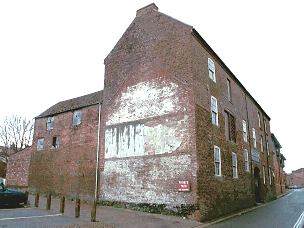
Louth former parish workhouse(?), 2001.
© Peter Higginbotham.
After 1834
Louth Poor Law Union was formed on 12th April 1837. Its operation was overseen by an elected Board of Guardians, 90 in number, representing its 88 constituent parishes as listed below (figures in brackets indicate numbers of Guardians if more than one):
County of Lincoln: Aby with Greenfield, Alvingham, Authorpe, Beesby in the Marsh, Bellau, Binbrooke St Mary, Binbrooke St Gabriel, Biscathorpe, Brackenborough, Burgh or Brough on Bain with Grisby, Burwell, Calcethorpe, Castle Carlton, Claythorpe, Conisholm, Covenham St Mary, Covenham St Bartholomew, Donington on Bain, Farforth with Maidenwell, Fotherby, Fulstow, Gayton-le-Marsh, Gayton-le-Wold with Grimblethorpe, Grainsby, Grainthorp with Ludney & Wrangholm, Great Carlton, Grimoldby, Hagnaby with Hannay, Hainton, Hallington, Haugham, Holton-le-Clay, Keddington, Kelsterne with Lambcroft, Legburne, Little Carlton, Little Cawthorpe, Little Grimsby, Louth Park, Louth (3), Ludborough, Ludford Magna, Ludford Parva, Mablethorpe St Mary and St Peter, Maltby-le-Marsh, Manby, Marsh Chapel, Muckton, North Reston, North Elkington, North Cockerington, North Ormsby, North Somercoates, North Coates, North Thoresby, Oxcomb, Raithby, Ruckland, Saleby with Theresthorpe, Saltfleet by St Clement's, Saltfleet by St Peter's, Saltfleet by All-Saints, Skidbrooke with Saltfleet Haven, South Willingham, South Cockerington, South Reston, South Thoresby, South Somercoates, South Elkington, Stenigot, Stewton, Strubby with Woodthorpe, Swaby, Tathwell, Tetney, Theddlethorpe St Helen's, Theddlethorpe All-Saints, Tothill, Trusthorpe, Utterby, Waith, Walmsgate, Welton-le-Wold, Withcall, Withern with Stain, Worlaby, Wyham with Cadeby, Yarborough.
The population falling within the union at the 1831 census had been 25,214 with parishes ranging in size from Ruckland (population 24) to Louth itself (6,927). The average annual poor-rate expenditure for the period 1834-36 had been £17,748 or 12s.1d. per head.
Louth Union workhouse was built in 1837 on Holmes Lane (now High Holme Road) at the north side of Louth. Intended to accommodate 350 inmates, its construction cost £6,000. The architect was George Gilbert Scott who, together with his partner William Bonython Moffatt, designed the workhouses at Boston, Horncastle and Spilsby.
The Louth design followed Scott's typical plan with an arched single-storey entrance block, three-storey main block, and infirmary and ancillary buildings to the rear. The workhouse layout can be seen on the 1888 map below.
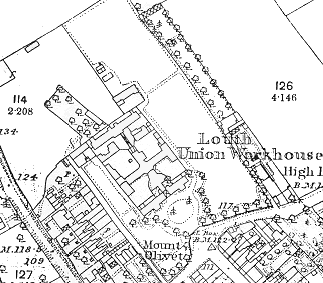
Louth workhouse site, 1888.
The single-storey entrance block would have contained the porter's lodge and Guardians' board-room. A new board-room was built at the front of the entrance block in 1904.
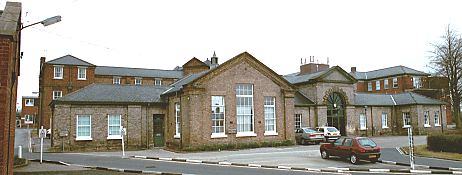
Louth entrance block and new board-room from the south, 2001.
© Peter Higginbotham.
The main accommodation block comprised the Master and Matron's quarters at the centre, with men's accommodation to one side and women's to the other. Cross-wings at each end would have accommodated the elderly and infirm.
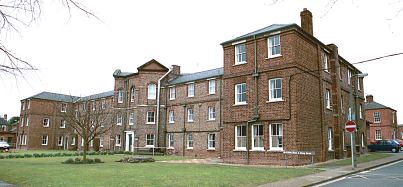
Louth main block from the east, 2001.
© Peter Higginbotham.
The area between the entrance and main blocks would have had dividing walls to create separate exercise yards. Traces of these can be seen in six-foot high piers at either side of the main-block's entrance.
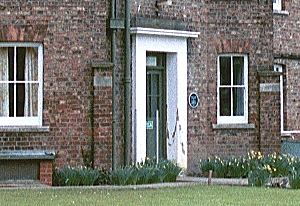
Louth main block entrance from the south, 2001.
© Peter Higginbotham.
A separate infirmary block stood at the rear. It would have originally been connected to the main workhouse by a covered walkway.
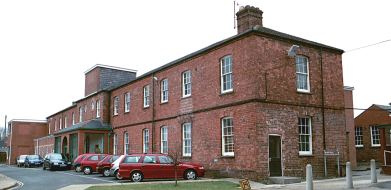
Louth infirmary block from the east, 2001.
© Peter Higginbotham.
Further hospital accommodation was added at the east of the site in the 1920s. The establishment later became Louth County Hospital.
Children's Home
By the 1920s, Louth Union had established a children's home at Nicholl Hill, Louth. It could house 12 children. In 1924, the foster mother in charge was Miss Clerehugh; in 1929, it was Miss Nellie Peck.
Staff
Inmates
Records
Note: many repositories impose a closure period of up to 100 years for records identifying individuals. Before travelling a long distance, always check that the records you want to consult will be available.
- Lincolnshire Archives, St. Rumbold Street, Lincoln LN2 5AB. Holdings include Guardians' minute books (1837-64, 1866-1930); Admissions and discharges (1872-1934 with gaps); Births (1847-65, 1910-36); Deaths (1837-66, 1914-36); Creed registers (1869-1930 with gaps); Lunatics register (1895-1905); etc.
Bibliography
- Painter, Bill (2000) Upon the parish rate: the story of Louth Workhouse and the paupers of East Lindsey (Louth: Louth Naturalists', Antiquarian and Literary Society)
- Udell, Joanne (2005) The Legacy of the Workhouse - Harsh Prison or Popular Myth (The Lincolnshire workhouse regime with investigation into Louth and Caistor workhouses 1834-1925. Illustrated, pp.38). Copies available at £5 (plus £1.50 UK postage for a single copy, or £1.80 for up to 3 copies). Please make cheques payable to Mr. R.I.Dickinson at The Hollies, 27 Station Road, Stallingborough, Grimsby DN41 8AQ. (Email enquiries to jill.mason@btinternet.com)
Links
- None.
Unless otherwise indicated, this page () is copyright Peter Higginbotham. Contents may not be reproduced without permission.


